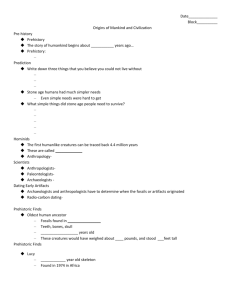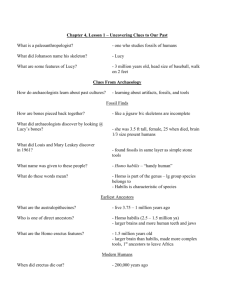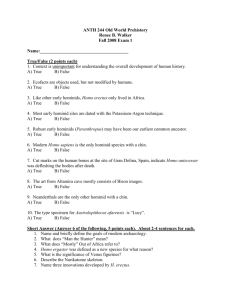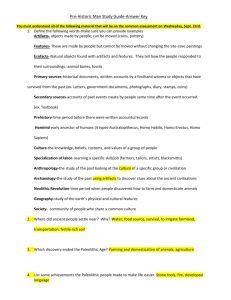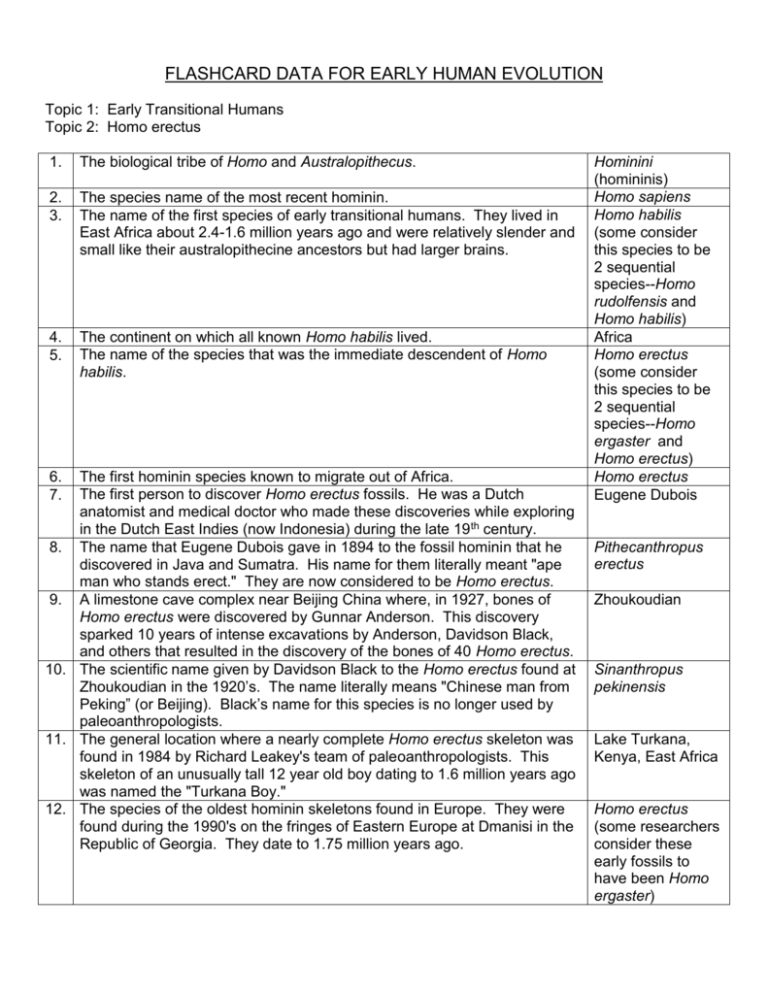
FLASHCARD DATA FOR EARLY HUMAN EVOLUTION
Topic 1: Early Transitional Humans
Topic 2: Homo erectus
1.
The biological tribe of Homo and Australopithecus.
2.
3.
The species name of the most recent hominin.
The name of the first species of early transitional humans. They lived in
East Africa about 2.4-1.6 million years ago and were relatively slender and
small like their australopithecine ancestors but had larger brains.
4.
5.
The continent on which all known Homo habilis lived.
The name of the species that was the immediate descendent of Homo
habilis.
6.
7.
The first hominin species known to migrate out of Africa.
The first person to discover Homo erectus fossils. He was a Dutch
anatomist and medical doctor who made these discoveries while exploring
in the Dutch East Indies (now Indonesia) during the late 19 th century.
8. The name that Eugene Dubois gave in 1894 to the fossil hominin that he
discovered in Java and Sumatra. His name for them literally meant "ape
man who stands erect." They are now considered to be Homo erectus.
9. A limestone cave complex near Beijing China where, in 1927, bones of
Homo erectus were discovered by Gunnar Anderson. This discovery
sparked 10 years of intense excavations by Anderson, Davidson Black,
and others that resulted in the discovery of the bones of 40 Homo erectus.
10. The scientific name given by Davidson Black to the Homo erectus found at
Zhoukoudian in the 1920’s. The name literally means "Chinese man from
Peking” (or Beijing). Black’s name for this species is no longer used by
paleoanthropologists.
11. The general location where a nearly complete Homo erectus skeleton was
found in 1984 by Richard Leakey's team of paleoanthropologists. This
skeleton of an unusually tall 12 year old boy dating to 1.6 million years ago
was named the "Turkana Boy."
12. The species of the oldest hominin skeletons found in Europe. They were
found during the 1990's on the fringes of Eastern Europe at Dmanisi in the
Republic of Georgia. They date to 1.75 million years ago.
Hominini
(homininis)
Homo sapiens
Homo habilis
(some consider
this species to be
2 sequential
species--Homo
rudolfensis and
Homo habilis)
Africa
Homo erectus
(some consider
this species to be
2 sequential
species--Homo
ergaster and
Homo erectus)
Homo erectus
Eugene Dubois
Pithecanthropus
erectus
Zhoukoudian
Sinanthropus
pekinensis
Lake Turkana,
Kenya, East Africa
Homo erectus
(some researchers
consider these
early fossils to
have been Homo
ergaster)
13. The term for a prominent projecting bony bar or brow ridge above the
eyes. This trait was characteristic of Homo erectus and some other early
humans. The two Latin words in this term literally mean “bony ridge above
the eye.”
14. The term for the distinctive shape of the incisor teeth of Homo erectus.
Their incisors usually had a "scooped out" appearance on the tongue side.
This characteristic is also found among many Asians and Native
Americans today.
supraorbital torus
(plural supraorbital
tori)
shovel-shaped
incisors
Topic 3: Climate Change and Early Human Evolution
1.
2.
3.
4.
5.
6.
7.
8.
The geological epoch during which all human species, beginning with
Homo erectus, evolved.
Which epoch was warmer on average, the Pliocene or the Pleistocene?
The number of ice ages that occurred during the Pleistocene.
When the last ice age ended.
What commonly happens to global sea levels during ice ages? Do they go
up, down, or stay the same?
The hemisphere that commonly has the most extensive glaciers during ice
ages. (northern or the southern?)
Another term for an ice age.
What commonly happened to the size of mammal bodies during the colder
periods of the Pleistocene Epoch?
9.
What generally happened to the size of human bodies as they evolved in
response to the climate changes of the Pleistocene Epoch?
10. What are we most likely living in now, a glacial or an interglacial climate?
Pleistocene
Pliocene
at least 4
about 10,000
years ago
go down
northern
glacial
They got larger in
response to colder
conditions. More
massive bodies
produce and retain
heat better than do
small ones
according to
Bergmann’s rule.
got larger
interglacial
Topic 4: Early Human Culture
1.
2.
The generic term for a thing that has been manufactured or intentionally
modified for some use. A stone tool such as a hand ax is an example as is
the computer that you are using.
The name of the first unquestionable stone tool tradition. They were
probably first made and used by early transitional humans in East Africa
2.5-2.4 million years ago. While the earliest sites with these tools are from
Ethiopia, simple tools of this kind were first discovered by Mary and Louis
Leakey associated with Homo habilis at Olduvai Gorge in Tanzania.
Subsequently, the name of this tool tradition was derived from that
location.
artifact
Oldowan Tool
Tradition
3.
4.
5.
6.
7.
8.
9.
10.
11.
12.
13.
The generic term for a tool made from a relatively large block of rock rather
than from the flakes that are removed from it by percussion flaking in the
manufacturing process. Most hand axes fit this definition.
The name of a very early tool tradition that involved the presumed use of
bones, teeth, and horns as clubs and other sorts of weapons by late
australopithecines and early humans. This idea was proposed in the
1940's by Raymond Dart but is rejected by most paleoanthropologists
today.
The generic term for an artifact made from a relatively thin piece of rock
knocked off of a larger rock usually by percussion flaking. Homo habilis
and Homo erectus used them mostly as cutting and scraping tools.
The name of the most well known stone tool making tradition of Homo
erectus. It first appeared about 1.5 million years ago in East Africa and
eventually spread throughout Africa, Southern Europe, and South Asia.
The most diagnostic artifact in this tradition is the hand ax.
A tool making technique in which a glass-like rock (e.g., obsidian, flint,
chert, and basalt) is struck with a heavy glancing blow from another dense
rock (a hammerstone) in order to cause a flake to be removed. When a
sufficiently large shock wave from a blow is directed into the target rock,
the elastic limit of the material is exceeded which causes one or more
flakes to be broken off.
A type of stone tool made from a core or large flake that has been
systematically worked by percussion flaking to an elongated oval shape
with one pointed end and sharp edges on the sides. In profile, it usually
has a teardrop or leaf shape. It is the most well known type of tool in the
Acheulean Tool Tradition of Homo erectus after about 1.5 million years
ago. Very likely, they were multipurpose implements used for light
chopping of wood, digging up roots and bulbs, butchering animals, and
cracking bones.
A term referring to sources of food and the way they are obtained (e.g.,
scavenging and hunting).
core tool
Osteodontokeratic
Tool Tradition
flake tool
Acheulean Tool
Tradition
percussion flaking
hand ax
subsistence
pattern or base or
strategy
The subsistence pattern of the late australopithecines and early transitional wild plant food
humans.
collecting and
occasional
scavenging for
meat and eggs
The subsistence pattern of late Homo erectus.
animal hunting and
carcass
scavenging along
with wild plant food
collecting
A term for climatic regions in between subtropical and subarctic zones.
temperate zone
These areas usually have winter snow and are too cold to grow oranges
and avocados. New York and Seattle are in this climatic zone.
The first hominin known to be able to live in temperate zones in addition to Homo erectus
tropical and subtropical ones.
14. The term for evolution in which natural selection is altered by cultural
inventions. Culture alters the direction of evolution by creating nonbiological adaptations to environmental stresses (e.g., wearing insulating
clothes on very cold days). This potentially reduces the need to evolve
genetic responses to the stresses.
Copyright © 2006-2012 by Dennis O'Neil. All rights reserved.
biocultural
evolution



